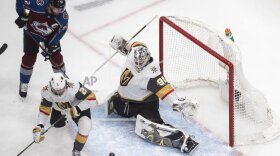When you think of sports in Las Vegas these days, hockey is probably the first thing that comes to mind, followed by basketball.
But there IS a history of motorsports in Las Vegas but like so much of early Las Vegas - it has mob connections.
Randy Cannon and Michael Gerry layout that connection in their new book: "Stardust International Raceway.”
The raceway, which was located off of what is now Rainbow Boulevard between Tropicana Avenue and Flamingo Road, was created and developed by Moe Dalitz, the legendary mob figure behind the Desert Inn and the Stardust.
Cannon said Dalitz developed the raceway along with a group of partners under the Stardust Racing Association title.
Ribbon cutting ceremony at Stardust International Raceway on September 21, 1965 produced a timeless Las Vegas gathering of racketeers, gamblers, government officials, and race car drivers. From left; Clark County Commissioner Bill Briare, unidentified, California Sports Car Club President Charles “Chic” Vandagriff, “New Yorker Harold Jason” (in sport coat leaning on vehicle), Carroll Shelby – creator of the Shelby “Cobra” and prominent race team owner, Allard Roen – convicted stock swindler and partner in the Desert Inn and Stardust Hotels as well as incorporator of the Stardust Racing Association, Leo Margolian (holding scissors) – general manager of Stardust International Raceway, race driver Parnelli Jones, Las Vegas City Councilman Grant Stewart (behind Margolian and Jones), Irwin Molasky (over Jones’ shoulder) – purchaser of the raceway property, developer of the raceway, and business partner of Moe Dalitz. Moe Dalitz, primary owner of the Desert Inn and Stardust Hotel-Casinos and president of the Stardust Racing Association, is 2nd from front right. Race driver Ken Miles is at the wheel of the Ford GT (chassis #1004), co-entered just three months prior by Shelby American and Walker racing in the 5 liter prototype class at the 24 Hours of Le Mans. / (Courtesy Las Vegas News Bureau
However, Cannon said the raceway was like a lot of other properties in Las Vegas at the time. It was used by people connected to the mob who were unable to get a gaming license as a way to legally conduct their business.
Cannon said people know mobsters were skimming the counting rooms at casinos like the Stardust and the Desert Inn, but there was a lot more going on at the time that few people know about.
“I think it was many times more complex than that and it involved these phantom pieces of property where people would do their real business and where the real ownership stakes in these casino properties were really bought, sold, traded, leveraged,” he said.
For example, when the raceway was closed and the property was sold. It was sold to a corporation that was the first publicly traded company to own a casino.
Cannon said some of the earliest wheelers and dealers in Las Vegas were involved in the development of the raceway, its closure and ultimate transformation into Spring Valley.
Denis Hulme in the #5 McLaren M8A leads the field into the first turn of the 1968 Stardust Can-Am Grand Prix. Mario Andretti, #3 Lola T-160, dives toward the apex but would strike the nose of Bruce McLaren's M8a tucked close behind Hulme. The high wing of Jim Hall's #66 Chaparral 2G is visible behind McLaren. Others seen jostling for a first turn advantage are Dan Gurney-#48 Lola, Chris Amon-#23 Ferrari with air brakes deployed on midship wing, Peter Revson-#52 McLaren, and Jerry Titus-#17 McLaren, (Courtesy of Author Collection)
When the raceway closed, there was still drag racing out there until - like so many other places in the city - suburbs took over.
“But as Spring Valley development continued, publicly racing there no longer made sense. It was just too close to suburbia at that point,” he said.
The raceway wasn' t the only place for motorsports in the valley. The horse track that once sat where the Westgate is now, held an Indy race in the 50s, Cannon said.
Las Vegas Park horse track is at center of image. Highway 91, the Las Vegas Strip, is angled from left-center to lower-right. Small oval in left foreground is Las Vegas Sportsdrome which featured local and regional jalopy, midget, and quarter midget races. 9-story Riviera Hotel tower is under construction at left-center of image. Frenchman and Sunrise Mountains are at top-right of image./(Courtesy of Author Collection)
“That was the first premiere-level professional sports events here and it was literally held on a one-mile dirt oval where the Westgate now stands,” he said.
To race on the dirt track, Indy cars would be fitted with dirt tires and gravel guards. The 1954 race was the finale and championship of the Indy season.
Motorsports has never really left the Las Vegas Valley. The Las Vegas Motor Speedway hosts two NASCAR events a year. NASCAR holds its award show in Las Vegas every year with a parade of cars, drivers and trailers down the Strip to kick the weekend off.
And the legendary Mint 400 ran in Las Vegas from 1967 to the late 80s. It was revived in 2008 and will be run this year in March.
Randall Cannon, co-author, "Stardust International Raceway: Motorsports Meets The Mob In Vegas, 1965-1971"












